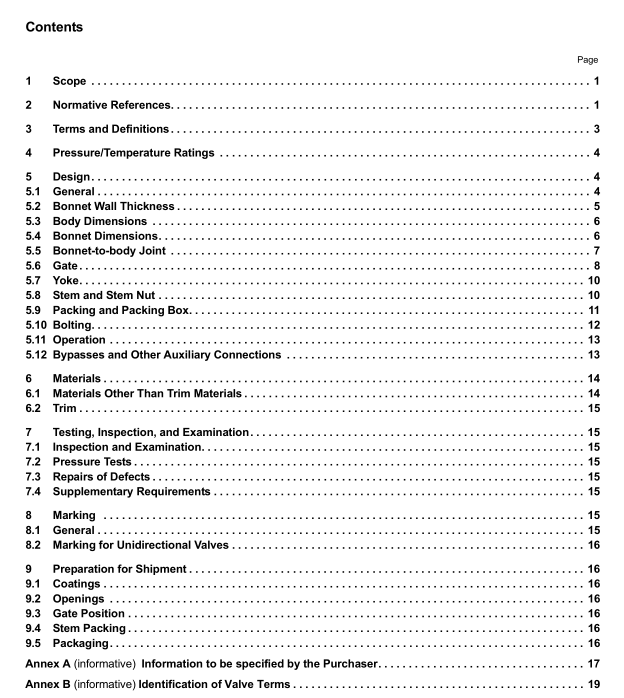API St 603 pdf download

API St 603 pdf download Corrosion-resistant, Bolted Bonnet Gate Valves—Flanged and Butt-welding Ends
5.3Body Dimensions5.3.1 Flanged Ends
5.3.1.1 Body end flanges shall comply with the dimensional requirements of ASME B16.5.Unless otherwisespecified, raised face end flanges shall be provided. The Purchaser may specify a flange facing finish other than thatspecified in ASME B16.5.
5.3.1.2Face-to-face dimensions shall be in accordance with ASME B16.10.Body end flanges and bonnet flangesshall be cast or forged integral with the body.
5.3.2 Butt-welding Ends
5.3.2.1 Butt-welding ends for valve sizes greater than DN 50 (NPS 2) shall confom to the requirements of ASMEB16.25 and B16.34 for the bore specified for use without backing rings. But-welding ends for valves DN 50 (NPs 2)and smaller shall conform to the requirements of APl 602.Conversion of a flanged end valve to a butt-welding valvefor Class 300 and above may be permitted by agreement between the Purchaser and manufacturer.
5.3.2.2 End-to-end dimensions for butt-welding end class designated valves shall be in accordance withASME B16.10, unless otherwise specified by the Purchaser.
5.3.2.3 Short pattern butt-welding end bolted bonnet valves are not permitted.
5.3.3Body Seats
5.3.3.1 The inside diameter of the seat opening shall not be less than that specified in Table A-1 of Appendix A ofASME B16.34 for the applicable valve DN or NPS and pressure class.
5.3.3.2 Body seats may be separate or integral with the body. When hard facing is furnished, it shall be applied as aweld overlay of AWS A5.13 ECoCr-A or AWS A 5.21 ERCoCr-A, except as provided in 6.2.2, and shall have aminimum finished thickness of 1.6 mm (0.06 in.).
5.3.3.3 Where separate seat rings are provided, they shall be shoulder or bottom seated, and either threaded orseal welded in place, except that for DN s 50 (NPs 2) rolled or pressed in seat rings may be used. Threaded seatrings may also be seal welded and shall be provided with lugs or siots to faclitate removal. The material used for sealwelding shall provide for the same corrosion resistance as the valve body material.
5.3.3.3.1 Welding on seat rings and valves including any associated PWHT shall be performed using qualifiedwelders and established procedures in accordance with ASME Section lX and the principles of Part D of ASMESection l,AppendixA.
5.3.3.4 Body seat rings shall have adequate seating area surface and shall have edges equipped with a radius orchamfer as necessary,to prevent galling or any other damage to the gate when the valve is operated againstpressure.
5.3.3.5 Sealing compounds or greases shall not be used when assembling seat rings; however, a light lubricanthaving a viscosity no greater than kerosene may be used to prevent galling of mating threaded surfaces.
5.4Bonnet Dimensions
5.4.1 When designing the stem, gland, lantern or spacer ring (if supplied) and backseat the manufacturer shallconsider stem guiding and the prevention of packing extrusion.
5.4.2 A machined conical or spherical backseat shall be provided in the bonnet to contact a corresponding seatingsurface on the valve stem. The backseat shall be either an integral surface or weld-deposited hard facing with aminimum finished thickness of 1.6 mm (0.06 in.). Weld deposited hard facing is permissible as noted in 5.3.3.2 and asagreed upon by Purchaser.
5.4.3 Bonnets shall be one-piece castings or forgings.The gland bolting shall not be anchored to the bonnet or yokethrough a fllet welded attachment or stud welded pins. The anchor design shall not include slotted holes or bracketswhich do not retain gland bolting during repacking.
5.4.4 Tapped test openings shall be provided only if specified in the purchase order.5.5Bonnet-to-body Joint
5.5.1The bonnet-to-body joint shall be a flange and gasket type and the gasket shall not extend beyond the inneredge of the bolt holes.
5.5.2 For Class 150 valves, the bonnet-to-body joint shall be one of the following types illustrated in Figure 7 ofASME B16.5.
—flat face;
raised face;
-tongue and groove;
-spigot and recess (i.e. male and female);ring joint.
5.5.3 For valves having pressure class designation Class > 150, the bonnet-to-body joint shall be as in 5.5.2, exceptthat the flat face joint is not permitted.
5.5.4 The bonnet flange gasket shall be suitable for a fluid temperature range -29 °℃(-20 °F)to 538 “C (1000 F)and be one of the following:
-solid metal, corrugated or grooved (profiled) metal gasket with suitable facing;
-metal ring joint;
-spiral wound metal gasket with filler and a centering/compression ring;
spiral wound metal gasket with filler, to be used only in a body-to-bonnet joint design that provides gasketcompression control.









